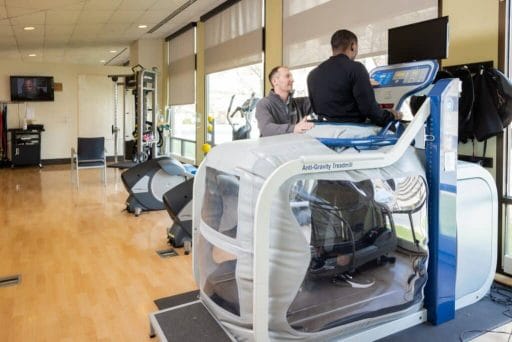Why Choose Us
Learn more about Good Shepherd Rehabilitation Hospital, a destination for recovery for stroke, brain injury, spinal cord injury and complex medical rehabilitation.

What was once the stuff of science fiction is now a reality for people with spinal cord injuries (SCI). Thanks to rapid technological innovations, patients with SCI have a better chance than ever before of restored function and mobility.
SCI outcomes are very unpredictable. Some patients make a complete recovery, and some suffer permanent paralysis and side effects such as a loss of bladder control or trouble swallowing (dysphagia). Advancements in technology such as bionic exoskeletons, electrical muscle stimulation, and in-home assistive technologies offer those with SCI the hope of a radically improved quality of life.
Good Shepherd Rehabilitation Network utilizes some of the most advanced technologies to treat spinal cord injuries. From devices that augment communication to robotic exoskeletons that teach a patient to walk, Good Shepherd can incorporate many leading-edge technologies into a patient’s rehabilitation.
Exoskeleton technology was initially developed for the U.S.military to help soldiers carry heavy gear over longer distances. This robotic technology is now adapted to help SCI patients stand and move during rehabilitation.
The Ekso wearable exoskeleton provides power and support to the patient’s legs. It promotes correct movement, challenging them as they progress toward walking on their own. This lower body wearable device is used in rehabilitation therapy at Good Shepherd to help patients recover more completely from an SCI.

For children with SCIs, Good Shepherd utilizes Trexo Plus, a wearable robotic gait training technology that encourages physical activity and independence. Trexo Plus allows kids with lower extremity weakness or spasticity to eventually stand and walk with a perfect gait and full-foot ground contact.
Trexo Plus attaches at the hips, knees and feet to help kids remain stable in a weight-bearing position. Assisted by robotics technology, kids push themselves forward, engaging their muscles. The child’s legs and feet move in a perfect pattern and, with repeat practice, the muscles strengthen and are trained to perform correctly. Over time, the Trexo Plus offers less assistance to encourage the child to walk independently.

The Bertec Balance Advantage System evaluates how well SCI patients use their sensory and motor systems. The Bertec system also provides interactive retraining exercises through virtual reality environments designed according to the patient’s needs. The goal is to take the patient from a high fall risk to low fall risk.
While watching a virtual scene, patients perform a series of exercises to test their posture, balance, and reaction time. Patients are safe from falls as they are secured in a safety harness and accompanied by a Good Shepherd therapist. The Bertec system incrementally steps up the difficulty of the exercises to gradually retrain patients to overcome their balance disorder.

The AlterG Anti-Gravity Treadmill supports motor learning while keeping a patient safe from falling.
The AlterG uses air pressure to decrease the impact of gravity and body weight during walking, running, or exercising on a treadmill. For patients whose lower body can’t withstand full weight bearing or exercise, AlterG’s reduced gravitational forces help patients move unrestricted and pain-free. This helps them build muscle strength, range of motion, balance and function.
A comfortable and safe air chamber wraps around a patient’s waist to reduce the gravitational load by up to 80%. This allows for a safe increase in cardiovascular activity without wear and tear on the body.

For SCI patients with dysphagia (difficulty with swallowing), Good Shepherd’s speech-language pathologists may recommend VitalStim, a neuromuscular electrical stimulation therapy.
VitalStim technology uses electrodes to apply a carefully calibrated electrical current to the front of the neck. The current stimulates motor nerves that cause a contraction of the muscles responsible for swallowing. At the same time, a Good Shepherd therapist helps the patient re-educate the muscles needed to complete the swallowing process. Repeated therapy gradually retrains the targeted muscle groups.

To learn more about the technologies Good Shepherd uses to treat spinal cord injuries, call us at 1-888-44-REHAB or fill out our contact form here.